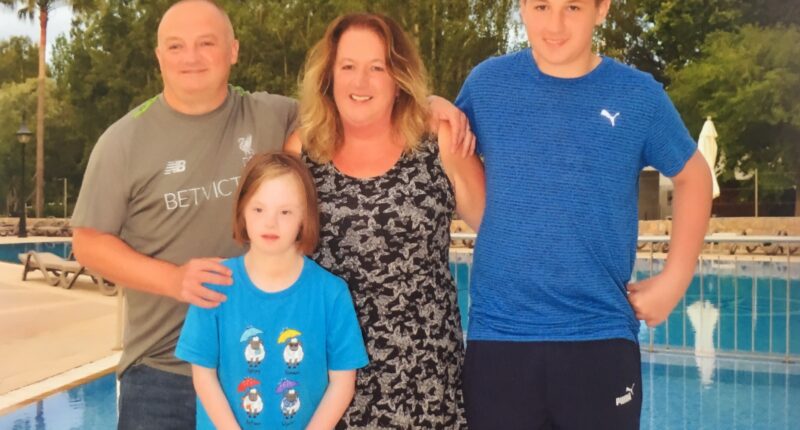PARENTS Wendy and Rob Stone were distraught after learning how difficult it would be to get money out of their disabled daughter Leah’s child trust fund.
Unable to bear the costs of the solicitor fees usually required to get access to £6,000 worth of savings, the Stone family, from Bristol considered not clawing the cash back.
Those responsible for children who do not have the mental capacity to manage their own money must apply to the court to gain access to child trust funds (CTF).
CTFs were long-term tax-free savings accounts for children born between September 1, 2002, and January 2, 2011.
Parents or guardians usually need to apply to the Court of Protection (COP) for a financial deputyship order so they can manage their disabled child’s account when they turn 18.
This often costs hundreds of pounds and takes many months to finalise.


Through CTFs, the government gave eligible parents vouchers worth up to £500 to invest, which would grow in value before maturity when the account holder turned 18.
It’s estimated that 200,000 people who have CTFs don’t have the mental capacity to access their money themselves, according to OneFamily, one of the UK’s largest CTF providers.
Wendy, 57, told The Sun: “Before Leah and her twin brother Jack were born just over 18 years ago, myself and my husband Rob didn’t know there would be any complications.
“While Jack was a healthy baby, when Leah was born we found out she had Down’s syndrome and has since been diagnosed with other learning difficulties including autism and more recently dementia.”
Most read in Money
“This has led to many challenges for us as a family over the years, but something we never expected was that Leah would be unable to access her CTF when she turned 18.
Wendy and Rob were hesitant to reclaim the cash when they realised that they’d have to fill in pages and pages of forms, as well as fork out hundreds if not thousands in solicitor fees.
The mum-of-two said: “I was so upset and frustrated that we would have to face this process and it seemed so unfair, particularly as Jack – who had grown up in the same house, with the same family and was born on the same day – would not have the same issues.
Rob, who works in the pension industry said: “We knew the COP route would be very difficult so we thought it might not be worth the hassle as we already have enough day-to-day pressures with looking after Leah.”
But after getting in touch with OneFamily, they managed to get access to the cash for free within two months.
This is because the provider is granting access to these accounts without following the rules set by the Ministry of Justice and by taking on the financial risk themselves.
This means that if problems were to arise, for example, in case of mistaken identity, OneFamily would have to refund the customer.
Another provider Foresters, along with OneFamily, has worked with The Investment and Savings Alliance (TISA) to create a Fair Access Protocol to help make it easier for families struggling to get hold of cash in these accounts.
This uses paperwork that parents or carers may already have to enable them to access their child’s money.
The process has helped over 1,000 families to unlock CTFs without having to apply to the COP.
However, families with other providers will find it much tougher and still need to go down the COP route.
Tessy Nyahasha, chief executive of OneFamily, said: “We believe a young person with mental incapacity should be able to access their child trust fund savings as easily as any other teenager.
“Expecting their family to have to complete a lengthy, stressful and sometimes expensive legal process on behalf of their child is unfair.
“Our simplified process mirrors that of the DWP in terms of the proof that is needed.
“In most of these cases, families are already receiving benefits from the government.
“By following that paper trail, we can establish the link between the parent who is looking after the young adult, and the owner of the money.
“This allows us to give customers access to their funds in a safe and efficient way.”
OneFamily argues that it’s unfair for families of disabled children to have to go through such a lengthy and costly process when CTFs tend to hold a smaller amount of cash.
The average CTF holds around £2,000 and OneFamily is calling for a change to the law to make it easier for all families to claim back the cash.
After managing to reclaim £6,000 in Leah’s CTF, Rob and Wendy said: “Now we have the money, we are looking forward to a big family holiday next year to create happy memories with Leah.
“We haven’t been away since before Covid, and although our holidays might look a bit different because of Leah’s additional needs, we can’t wait to get away as a family.”
However, the Ministry of Justice (MoJ) which oversees the Court of Protection route, argues that OneFamily’s approach still doesn’t provide disabled children with the same protections delivered in the Mental Capacity Act.
An MoJ Spokesperson said: “We cannot support a scheme that potentially opens up a disabled person’s finances to fraud – which is why we’re helping families access these funds quicker via the Court of Protection while maintaining vital protections.”
The wait times in the Court of Protection have been reduced from 24 to eight weeks in recent months.
If you’ve got a disabled child and are struggling to get access to a child trust fund, call your provider and ask for their advice.
How did child trust funds work?
When CTFs became available, HMRC sent the parents or guardians of qualifying children a starting payment voucher of £250 (or £500 if they were on a low income).
This voucher could then be used to set up a CTF account in the child’s name.
If you didn’t use the voucher within one year, HMRC would set up a CTF account in your child’s name on your behalf.
Money in a Child Trust Fund account belongs to the child and is “locked in” until they turn 18.
There were three types of accounts that could be opened with the voucher:
- Cash Child Trust Fund: This is where you could make deposits just as you would for a bank or building society account, which can earn tax-free interest.
- Stakeholder Child Trust Fund: This is where the savings in the account are put into a wide mix of low-risk stock market investments.
- Shares-based Child Trust Fund: The savings in the account could be put into the stock market via an investment fund of your choice or select your own investments.
The savings would grow over time thanks to tax-free returns.
How can you claim child trust funds?
A CTF matures on the account holder’s 18th birthday.
At this point, the child automatically takes over the account and no more money can be added – unless they have the mental capacity to do so.
Until your child withdraws or transfers the money, it stays in an account that no one else has access to – unless you apply for financial deputyship to help make a withdrawal.
If you are one of the tens of thousands of young adults who haven’t claimed their account, the government has an online tracing service where you can find out if you have one and which provider it’s with.
To find out more, you’ll need a government gateway login and National Insurance number.
If you are a parent looking to find out about your child’s fund you can either access it online, or you’ll need to send a letter to HMRC with the following details:
- Full name and address
- Child’s full name and address
- Child’s date of birth
- Child’s National Insurance number or Unique Reference Number if known
What can you do once you’ve claimed the money?
While it might be tempting to spend all the cash at once, there are other options available to you.
Households can request the cash directly to their bank account, transfer it into an ISA or invest it.
Here are the full details of what can you do.
Cash it in
You can ask your CTF provider to hand over the money and get it paid into a bank account.
You’ll need to share the bank account details you wish to transfer the cash into with HMRC.
Remember you’ll need to be at least 18 before you can cash out the savings.
Transfer it into an ISA
You can transfer it into an ISA.
An ISA is an Individual Savings Account and you don’t pay tax on the interest you earn in these types of accounts.
You can have a cash ISA – although the interest rates on these are typically lower than a standard savings account – or a stocks and shares ISA, which lets you invest the money if you don’t mind taking some risk.
A good option for young people saving to buy their first home is the Lifetime ISA.
You can stash £4,000 a year into these accounts and the government will give you a 25% bonus on your savings as long as you use it to buy your first property, or if you wait until retirement age to access the cash.


It won’t incur income or capital gains tax and will sit until the account holder does something with it.
This isn’t a great option though as your money won’t be earning interest, which means its value in real terms is often eroded by inflation.










